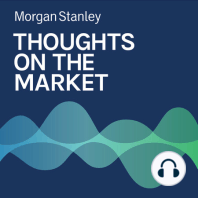3 min listen
Mike Wilson: Fixation on the Fed
ratings:
Length:
4 minutes
Released:
Jan 24, 2022
Format:
Podcast episode
Description
All eyes are on the Fed as they implement a sharp pivot to account for higher inflation being felt by consumers and businesses alike. With these shifts we turn our attention to the ‘Ice’ portion of our ‘Fire & Ice’ narrative: slowing growth.----- Transcript -----Welcome to Thoughts on the Market. I'm Mike Wilson, Chief Investment Officer and Chief U.S. Equity Strategist for Morgan Stanley. Along with my colleagues, bringing you a variety of perspectives, I'll be talking about the latest trends in the financial marketplace. It's Monday, January 24th at 11:30 a.m. in New York. So let's get after it. Investors have recently become fixated on the Fed's every move. That makes sense, with the Fed pivoting so aggressively on policy over the past few months. It also fits nicely with the first part of our well-established "Fire and Ice" narrative and our view that equity valuations are vulnerable. The reason for the Fed's sharp pivot is obvious, as inflation has overshot its goals - leading to problems for the real economy, not to mention the White House. When the Fed first announced its inflation targeting policy in the summer of 2020, it was appropriate given the deflationary effects of the pandemic. Therefore, it's now just as appropriate for the Fed to tighten at an accelerated pace to fight the inflation overshoot. However, this is a big change for a Fed that has been fighting the risk of deflation for 20+ years, and it has market implications. Importantly, consumers are truly starting to feel the impacts of inflation, with the University of Michigan Confidence Survey currently at levels typically observed only in recessions. Small businesses are also feeling the pain, as demonstrated by their difficulty finding employees and the prices that they are paying for supply and logistics. In short, the Fed is serious about fighting inflation, and it's unlikely they will be turning dovish anytime soon, given the seriousness of these economic threats and the political cover to take action. The good news is that markets have been digesting this tightening for months. Despite the fact that major U.S. large cap equity indices are only down 10-15% from their highs, the damage under the surface has been much worse for many individual stocks. Expensive, unprofitable companies are down 30-50%. This is appropriate, in our view, not just because the Fed is pivoting, but because these kinds of valuations don't make sense in any kind of investment environment. In short, the froth is coming out of an equity market that simply got too extended on valuation - the key part of our 2022 outlook published in November. But attention should now turn to the Ice part of our narrative - slowing growth. As we've been writing for months, we view the current deceleration in growth as more about the natural ebbing of the cycle than the latest variant of COVID. In fact, there are reasons to believe that we are closer to the end than the beginning of this pandemic. However, that also means the end of extraordinary stimulus, both monetary and fiscal. It also means looser supply chains as restrictions ease and people fully return back to work. Better supply is good for fighting inflation, but it may also reveal the degree to which demand has been supported and overstated by double ordering. This would fit nicely with the 1940s analogy that we have also detailed in our 2022 outlook. In brief, the end of the Second World War freed pent up savings and unleashed demand into an economy unable to supply it. Double digit inflation ensued, which led to the first Fed rate hike in over a decade and the beginning of the end of financial repression. Sound familiar? Shortly thereafter, inflation plummeted as demand normalized, but the Fed never returned to the zero bound on interest rates. Instead, we began a new era of shorter booms and busts as the world adjusted to the higher levels of demand, as well as cost of capital and labor. The end of secular stagnation and financial repr
Released:
Jan 24, 2022
Format:
Podcast episode
Titles in the series (100)
Mike Wilson: Are U.S. Economic Indicators Flashing Yellow? by Thoughts on the Market
